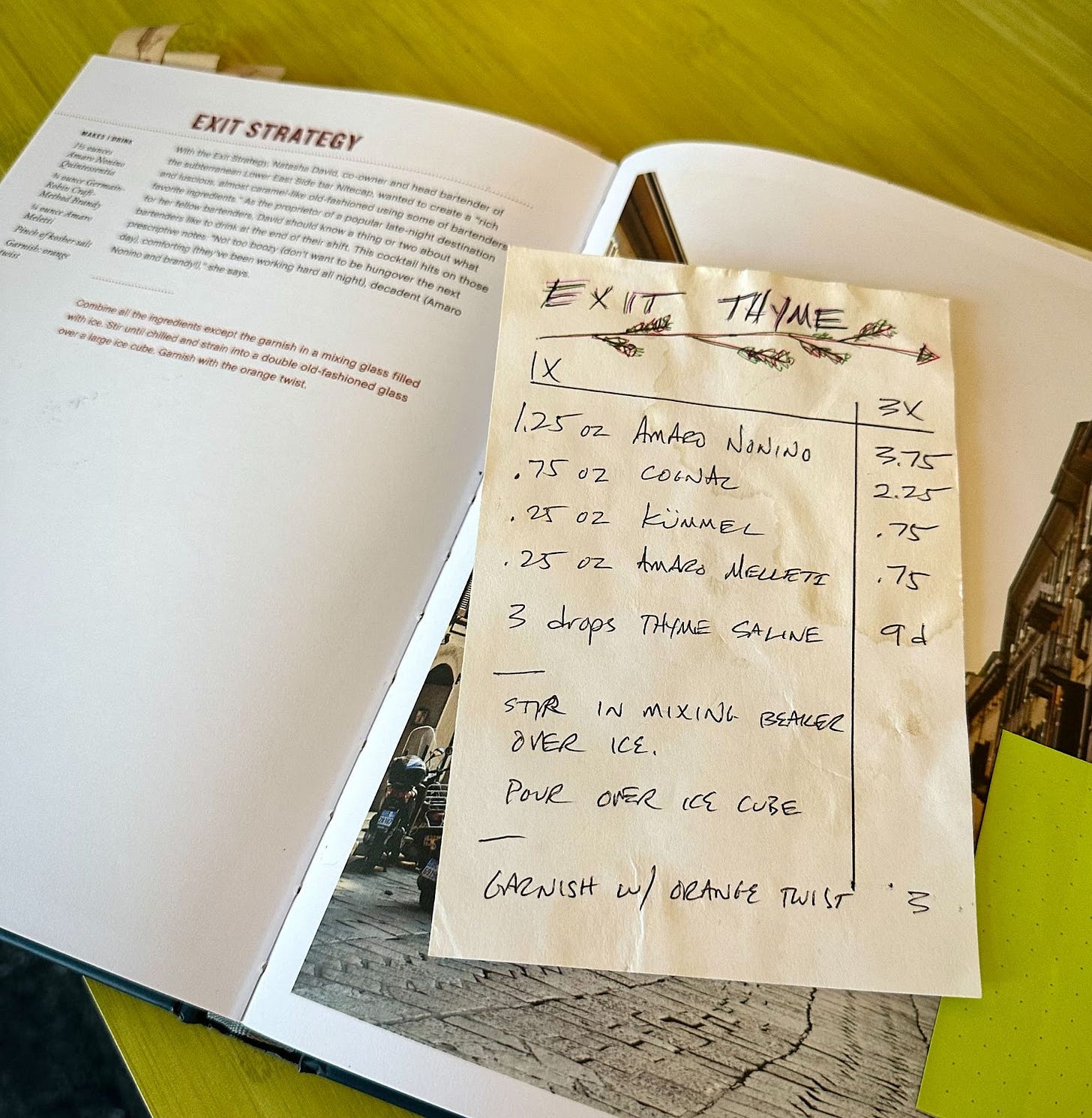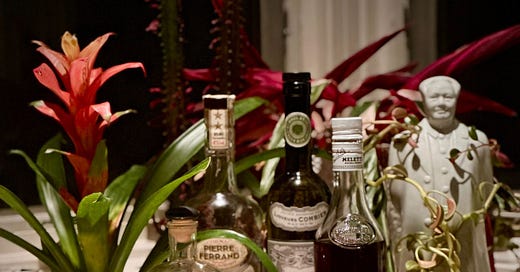It’s Exit Thyme (Cocktail) For Me & ICYMI - Great Reads Worth Reading
Issue No. 14 - Some great reads to help you be interesting at the cocktail party, and sharing personal some news - with a cocktail pairing to match
In today’s issue we explore an original riff off a great cocktail that includes the interesting doppel-kümmel liqueur - along with some great reads to help you be the most interesting person at the cocktail party. I look forward to your comments and thoughts. Thanks for reading and I hope you enjoy! Cheers!
This Week’s Cocktail: Exit Thyme Cocktail
This week's cocktail is a riff off what in my mind is a modern classic - the Exit Strategy - which I created early this summer for an event I was invited to mix at. The event’s theme was “Spring Has Sprung”, so I wanted to play with some flavors from the garden. I also was going to need something I could easily scale up and serve a lot of quickly. As is often the case, I reached into my library of cocktail books and started browsing for inspiration. That’s when I came across Exit Strategy in Brad Thomas Parsons’ excellent book Amaro - one of my personal favorites. I’ve made the drink before and loved it.
The Exit Strategy was created by Natascha David, proprietor of the intimate subterranean New York cocktail bar Nitecap. David opened Nitecap on New York’s Lower East Side in 2014 and soon won fans across New York’s bartending set, who became frequent late-night guests at her bar as they marveled at her approach - both rooted in cocktail heritage and yet pushing into new territory. Unfortunately, the bar was a COVID casualty - like many great bars and restaurants across the world, her bar was unable to stay afloat and financially solvent while shuttered. It is a shame, but the good news is that many of her creations have found their way into countless books and articles - including Parson’s.
While not quite what I classify as a low-ABV cocktail or shim, the Exit Strategy does flip the conventional proportions of spirit and modifier, and as a result it is not too boozy. It is a comforting, slow-sipper that features two different amari - Amaro Nonino and Amaro Meletti - to create a complex and yet balanced cocktail that leans just a touch sweet. Looking at the spec and reading about it again, I had an idea.
Let’s have some fun - bringing a different herbal signature into the cocktail.
The name Exit Thyme actually came to me first - which sometimes happens - opening the door (or maybe ‘the bottle’ would be a more apt analogy) to concepts and ideas to then try to execute on. It is certainly possible that the name came to me as I thought about what was going on in my professional life (more on that in the newsletter below), but it was also because I had just been out harvesting some herbs from the garden, and the thyme was out of control!
With that, I decided to riff on the amari and modifiers in the Exit Strategy to see what was possible.
Riffing is one of the great joys of mixology.
Just as in cooking or any other craft or art form - from music to painting to you name it - playing with an idea or a form of something great that has come before can lead to new discoveries and ideas. When done well, you honor the original and adapt it to explore the template and add your own flair, creativity, technique, and experience - learning along the way.
You might even say that riffing - or experimenting - is the very essence of mixology, otherwise you are just following recipes and instructions. To be clear, we all start with recipes - whether we are just starting out, learning from the classics, or exploring something new we have not tried before. So there is nothing wrong with that! But why be constrained when there is so much to explore?
Digging out the… kümmel!
Looking at the construction of the Exit Strategy there were two components I most wanted to play with. One was the amari in the drink. I had been given a bottle of Combier Doppelt-Kümmel that I had not even opened yet, but I knew it was likely to have a new herbaceous angle. I dug around in my basement - where I keep my deep catalog - pulled it out and cracked it open. I took a small sip straight from the bottle. The kümmel’s flavor was wonderful - packed with caraway, fennel, and cumin, and with just a hint of thyme on the palette. (See, there is a reason to have an eccentric collection of booze!)
Kümmel - for those unfamiliar - is an herbal liquor that originated in the southern-Baltic region of Europe and is primarily flavored with caraway seed. Use of caraway as a “cover” - a basic botanical flavor - in spirits across Europe was not unusual, and by the seventeenth century mention of “spiritus carvi” or “caraway spirit” was common in the medical texts of Europe (this is medicine!). By 1823 a recipe for doppel-kümmel showed up in German distillers manuals, with a doubling of the herbs and spices used - with fennel and cumin added as well as caraway seed. Years of progress and commercialization of kümmel followed and by the late nineteenth century kümmel could be found all across northern Europe and the United Kingdom.
Kümmel enjoyed its heyday in cocktailing in the early twentieth century, with the most famous cocktail being the simple and delicious Silver Bullet, which made an appearance in the Savoy Cocktail Book published in 1930. However, the Second World War was not good for kümmel, devastating production across Europe, especially in its home - the Baltic region. The bottle I have is a faithful recreation of an early doppel-kümmel recipe, now made by the excellent Combier Distillery located in the Loire Valley of France. Combier is known for its fine liqueurs, and it is wonderful that they brought this great kümmel formulation back.
Pump up the thyme, pump it up, while your feet are stompin’!
The second component of the Exit Strategy I decided to play with was the salt. While the Exit Strategy calls for a pinch of salt, I decided this offered a perfect opportunity to play with a saline solution and infuse it, pumping up the thyme flavor in the cocktail in the process. (Ok, there is literally no reason to abuse the lyrics to the Technotronic’s great Pump Up the Jam in the sub-heading, but hey, let’s get the party going with some great tunes!)
Salt is something not many consider as an element in cocktails - other than the rim of a margarita, of course. But just as in cooking, it can be an important enhancer and modifier to other flavors. Many mixologists would go so far as to say that most drinks benefit from a few drops of saline. Used in small amounts, salt has the ability to suppress bitter flavors while accentuating sweet, sour, and savory ones. And one of the best ways to incorporate salt into a drink, is with saline solution. It is much easier to mix liquids with liquids than with solids that need to dissolve.
Typically a saline solution in mixology is twenty percent which is plenty salty, but not overwhelming - with two to five drops from an eye-dropper doing the trick for most cocktails. So that’s what I went with here - simmering some thyme in 80 grams of water and adding 20 grams of salt to make a 20% saline solutions (see notes below for more on the process).
Dialing it in
As I mixed my trials of the new Exit Thyme, I played with the proportions of the kümmel with the amari in the Exit Strategy. I eventually landed on cutting back the Amaro Nonino a quarter of an ounce and subbing in the kümmel in the same amount - keeping the Amaro Meletti a quarter of an ounce. I also played with the saline, landing on three drops.
Those paying close attention will note that this is now the third cocktail I have featured with Amaro Nonino, and so have written about that before (here and here). If you only have a few amari in your bar, you should have this one. It is expensive, but as you can see, it is versatile! And as for Meletti, it is a great, lower cost amari that presents with sweet caramel, cola, and distinctly floral note well balanced with just the right amount of herbaceous bitterness. Meletti is also great with a splash of mineral or soda water on a hot summer afternoon and fun to play with across the cocktailing spectrum.
And instead of the brandy used in the Exit Strategy, I reached for the cognac. Why? Because cognac is good brandy!
Cheers! No doubt you too will one day have an Exit Thyme.

Exit Thyme Cocktail spec, serves one:
1.25 oz (~38-40 ml) - Amaro Nonino Quintessentia
.25 oz (~8 ml) - Doppel-Kümmel (Liqueurs Combier Doppelt Kümmel Extra recommended)
.25 oz (~8 ml) - Amaro Meletti
.75 oz (~25 ml) - Cognac (Pierre Ferrand Cognac 1840 recommended)
3 drops - Thyme Saline Solution (see notes)
Garnish with an Orange twist
The process:
Combine all ingredients in a cocktail mixing glass, add ice. Stir until well chilled. Strain into a cold rocks glass, over ice. Squeeze orange twist over the glass and gently wipe on the rim before placing in the glass.
Notes:
A 20% saline solution is 20 grams of salt mixed with 80 grams of water (not 20 grams salt in 100 grams of water, that would be a 16-17% saline solution). The percentage refers to the total solution by weight, not the percentage of the weight of the water you're dissolving in. This is a great use-case for a digital kitchen scale, which makes this easy. (More gadgets!)
For the “drops”, best to use a glass eye-dropper like you find in many bitters bottles. If you grab one from a bitters bottle try to give it a good cleaning first. Pop off the rubber top and use a narrow wire brush like you would to clean out a sipping straw. (And we are all using reusable straws now, right? Good.) If that’s not possible, give it a good rinse and shake it out as best you can. A little water in there won't do any harm.
Bonus spec - Exit Strategy Cocktail, serves one:
This is the spec I riffed off to make the Exit Thyme.
1.5 oz (~45 ml) - Amaro Nonino Quintessentia
.25 oz (~8 ml) - Amaro Meletti
.75 oz (~25 ml) - Brandy (Germain-Robin Craft-Method Brandy or above-average brandy recommended)
Pinch - Kosher or fine, high-quality sea-salt
Garnish with an Orange twist
The process:
Combine all ingredients in a cocktail mixing glass, add ice. Stir until well chilled. Strain into a cold rocks glass, over ice. Squeeze orange twist over the glass and gently wipe on the rim before placing in the glass.
Notes:
This spec was created by Natasha David and is taken from Amaro: The Spirited World of Bittersweet, Herbal Liqueurs, with Cocktails, Recipes, and Formulas, by Brad Thomas Parsons, Ten Speed Press, 2016.
Instead of analysis, this week it is ICYMI! - Great reads worth reading
A good cocktail typically accompanies a great conversation… so you need something to talk about. Here are some recent articles you may enjoy and to help you be the most interesting person at the party. Some are commerce industry related, and some are… well, interesting.
Some pandemic-era habits just won’t die. Maybe it feels like the pandemic was just a weird fever dream and nothing really changed, but from how we shop and work to how we connect with others, the pandemic greatly accelerated our adoption of some key technologies and new habits. Americans aren’t going to go back to the way things were before. (Wall Street Journal)
If you are relatively “well off” but don’t feel like it, you are not alone. In a nationwide survey of over 1,000 objectively wealthy Americans — defined as making at least $175,000 a year, roughly the amount required to crack the top 10% of US tax filers — a full quarter of them said they were either “very poor,” “poor,” or “getting by but things are tight.” Half described themselves as just “comfortable.” (Bloomberg)
Next slide, please: A brief history of the corporate presentation: From million-dollar slide shows, operettas, dancers, to Steve Jobs’s introduction of the iPhone - a bit of show business never hurt plain old business. (MIT Technology Review)
OK, it was a memorable presentation, but let’s stop talking about Job’s iPhone launch in 2007. Turns out 2012 was a year that really changed everything. Following 2012, it was as if the whole culture itself became more depressed, anxious, angry, and spent far too much time staring at their phones. Most of the cultural issues that continue to dominate the public discourse started to take off precisely around 2012. That was the year the majority of the developed world switched to finally owning a smartphone. (The Intrinsic Perspective)
A new Battle Royale? TikTok versus Amazon versus Shein. TikTok has confirmed that it’s testing a new in-app “Trendy Beat” shopping section where it is offering products for sale that are shipped and sold by a subsidiary of its parent company, ByteDance. The feature is currently being tested in the U.K. (TechCrunch). See also: Shein takes on Amazon in the business of selling everything, positioning itself as a marketplace for practically anything. (Wall Street Journal) See also: Amazon is looking to boost its TikTok-style “Inspire” shopping feed and is offering to pay influencers $25 a video. (TechCrunch)
Salesforce faces a whistleblower lawsuit over its CDP 'Genie' claims. At the center of this lawsuit is the claims Salesforce made at the September 2022 Dreamforce conference that its customer data platform (CDP) is 'real-time' (Shocking! It’s not?!?). Now its former head of product has filed a lawsuit. (Law.com)
Product-led Growth (PLG) has been touted as a panacea for tech companies, but it turns out it is more complicated than that. To be successful PLG strategies often have to be complemented by elements of a more traditional enterprise model to succeed - integrated with PLG concepts and capabilities. Even the consultants see it now. (McKinsey Research)
China’s biggest e-commerce firms are moving aggressively toward selling more low-price, discounted goods. As Chinese shoppers increasingly hunt for bargains amid economic stagnation, Alibaba, JD.com, and others have embarked on campaigns to promote low-price goods to cater to yuan-pinching shoppers dealing with the struggling Chinese economy through new services and incentives for merchants. (Wall Street Journal). See also, Alibaba named a new CEO in a surprise shake-up. Growth has sputtered in the post-crackdown era and amid a slowing Chinese economy. (Bloomberg)
Sometimes it seems that the more things change the more they stay the same. How understanding the first stock exchange - founded in Amsterdam in 1602 to fund the Dutch East India Company (VOC) - still explains a lot of the irrational, emotional behavior of investors today. It has never been more important to understand financial history and psychology of markets and investors. Fascinating read. (Periscope)
The often wacky, sometimes wicked, and always wondrous eras of Barbie. The doll has been through a lot since her creation in 1959 - a rise to fame, a public backlash, a breakup, a reconciliation, and much more. Now, though, she’s entered her latest era - Blockbuster Barbie. (The Ringer)
Amazon cuts dozens of private label brands as it battles costs and regulators. (Wall Street Journal) See also: Amazon restarts Amazon Shipping. Paused early in the pandemic, the program handles packages from other websites and selling channels - if they sell on Amazon - and competes directly with FedEx and UPS. (Wall Street Journal)
What if Generative AI turned out to be a Dud? Few things have been more hyped in recent memory than Gen-AI. If hallucinations aren’t fixable, generative AI probably isn’t going to make a trillion dollars a year. And if it probably isn’t going to make a trillion dollars a year, it probably isn’t going to have the impact people seem to be expecting. And if it isn’t going to have that impact, maybe we should not be building our world around the premise that it is. (Marcus on AI). See also, Sure AI is hot, but is it an actual market or just a platform piece? (TechCrunch+)
And now for something completely different… San Franciscans are having sex in robotaxis - and nobody is talking about it. As autonomous vehicles become increasingly popular in San Francisco, some riders are wondering just how far they can push the vehicles’ limits—especially with no front-seat driver or chaperone to discourage them from questionable behavior. The companies themselves are - um - looking the other way (hopefully). (The SF Standard)
Note: Yes, some of these articles reside behind firewalls. Sorry about that. But then again you are a grown up, time to pay up for quality media… Who do you think writes the good stuff? Robots?
About my recent news - leaving Bloomreach
Many of you probably saw my recent news on LinkedIn, but those of you who did not, I have left Bloomreach. And yes, for those paying close attention, my picture on LinkedIn featured the Exit Strategy ingredients behind that empty glass.
I was at Bloomreach for just over four fabulous years, and I leave with my glass not empty, but full. Full of gratitude and appreciation - for what we accomplished and for the tremendous team I got to work with inside and outside of Bloomreach - as we transformed the company from essentially a commerce search solution provider and put it on a new path of growth as a commerce experience and marketing innovator. We essentially tripled the business.
Leaving Bloomreach also means that I will unfortunately not be able to serve out the term I was elected to on the MACH Alliance Executive Board. Many of you - and others in the Alliance - voted for me. I am grateful for your support. I remain engaged there, and look forward to remaining on the Advisory Board of the Alliance and contributing my perspective on how the Alliance can evolve and mature from that vantage point.
I leave Bloomreach in order to pursue new creative and professional challenges, of which this newsletter will be a key element. I am not ready to share the full scope and shape of what comes next just yet, but I do intend to remain engaged in the commerce tech and services ecosystem with something that will be differentiated, fill a void, be focused on the commerce tech & services communities - and yes indeed... it will involve some cocktails!
And for the time being, I will continue to be involved with Bloomreach in a number of ways even as I turn independent - including the Commerce Experience podcast and Commerce Pulse quarterly webinar - where I analyze and contextualize digital commerce results aggregated from Bloomreach’s customer base. I’m looking forward to those, as well as hosting the digital live-stream of the Bloomreach Edge Summit this week where we will deep-dive into how AI and Generative-AI will shape digital commerce and marketing moving forward. (It is not too late to register!)
Thank you all who have reached out or commented on my announcement. It means a lot to me, and I can’t wait to share more soon.
Thus, it is indeed… Exit Thyme!
Recent Podcasts:
Commerce Experience Podcast - Ep. 68: The Undeniable Impact Of AI On Marketing with Daniel Edelman CEO of Runic, Keval Baxi CEO of Codal, and Paul Blankley CTO at Zenlytic.
Commerce Experience Podcast - Ep. 66: Navigating the Path to Composable Commerce with Michael Harvey, Chief Technology Officer at Corra.
Commerce Experience Podcast - Ep. 67: Conquering New Markets And Navigating International Expansion, and a unique e-commerce model of Thomann Music with Christian Maaß, CDO & MD at Thomann Music.
Join me and meet at these upcoming events:
Events and conferences are entering the summer hiatus, but there is one more important one to have on your radar - and you can join via live-stream:
Bloomreach Edge Summit - Napa Valley - August 24-25, 2023. Join online or in-person in beautiful Napa Valley, CA to explore the impact Generative-AI will have on digital commerce and marketing. Get educated, discover key use-cases, and have a POV on the impact on your business and clients. If you can’t make the physical event, join us for the digital livestream. But if you are going to be there in person, be sure to come by and say hello. We will probably be drinking some fabulous wine instead of cocktails, but hey… that sounds pretty good too!
If you are looking for me online, you can find me here, here, and here. Please reach out with your feedback on the newsletter and if there is anything I can do to help you.
Be safe, be well, and here is to good business! Cheers!
- Brian









Love it! Very pleasant reading!